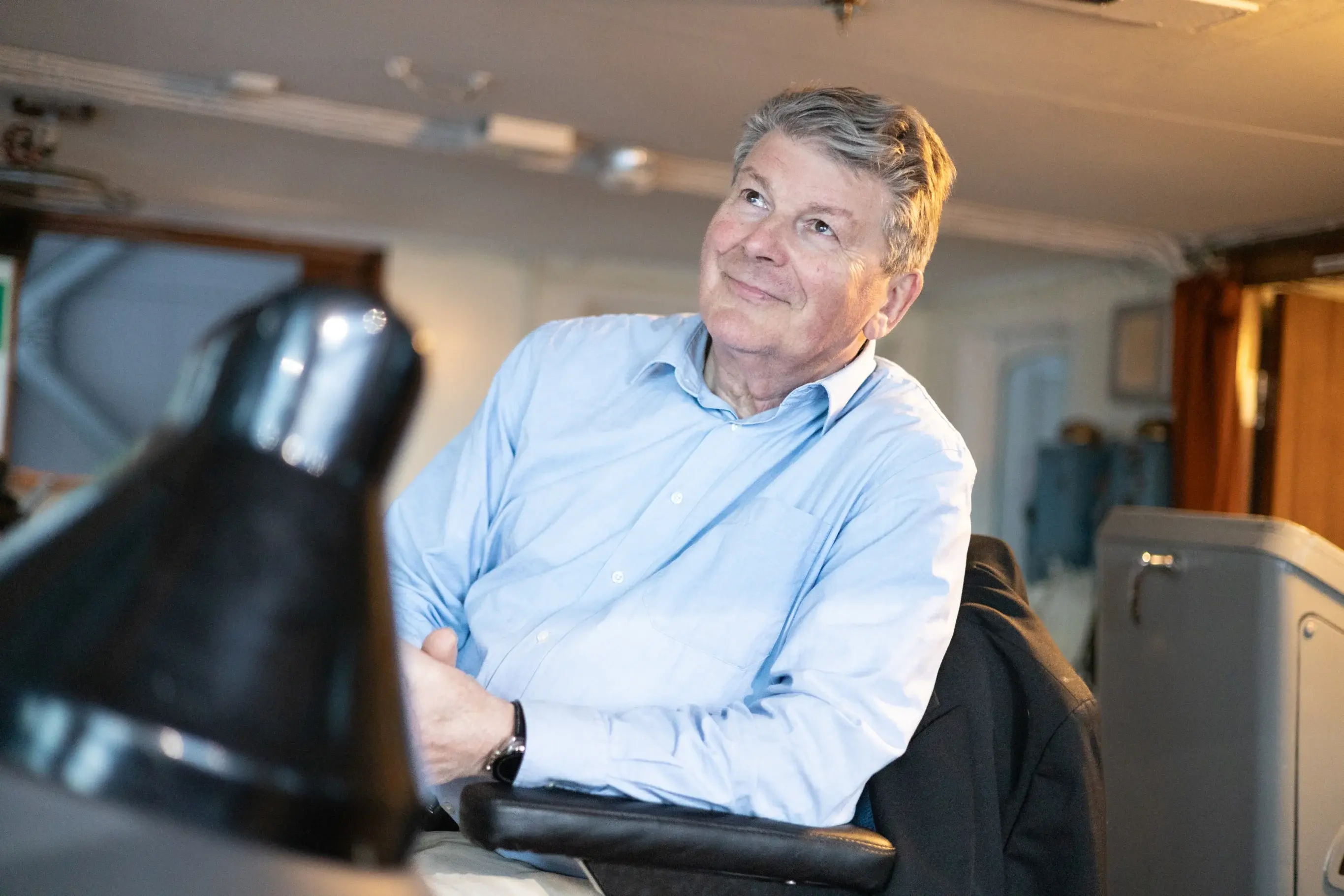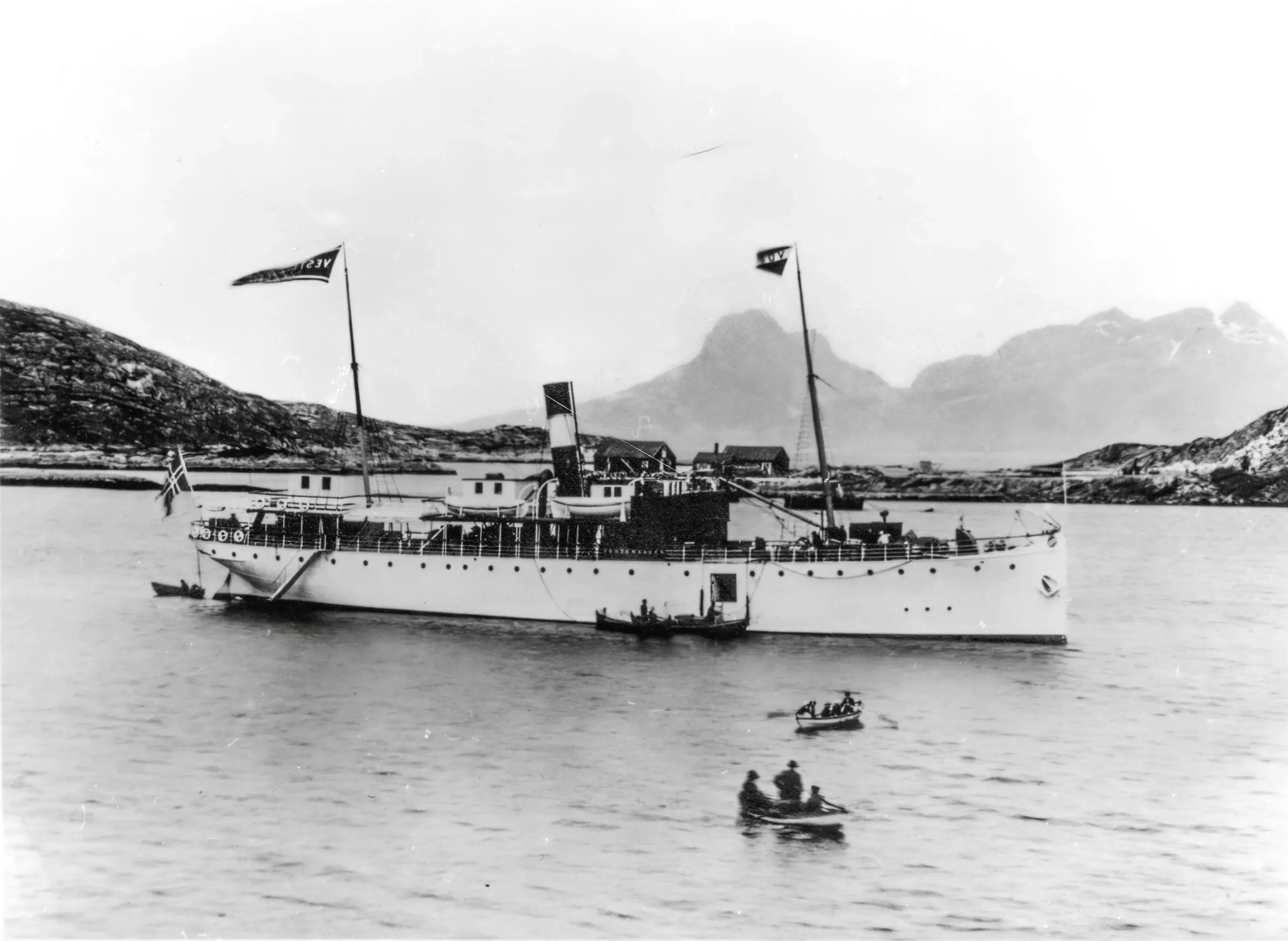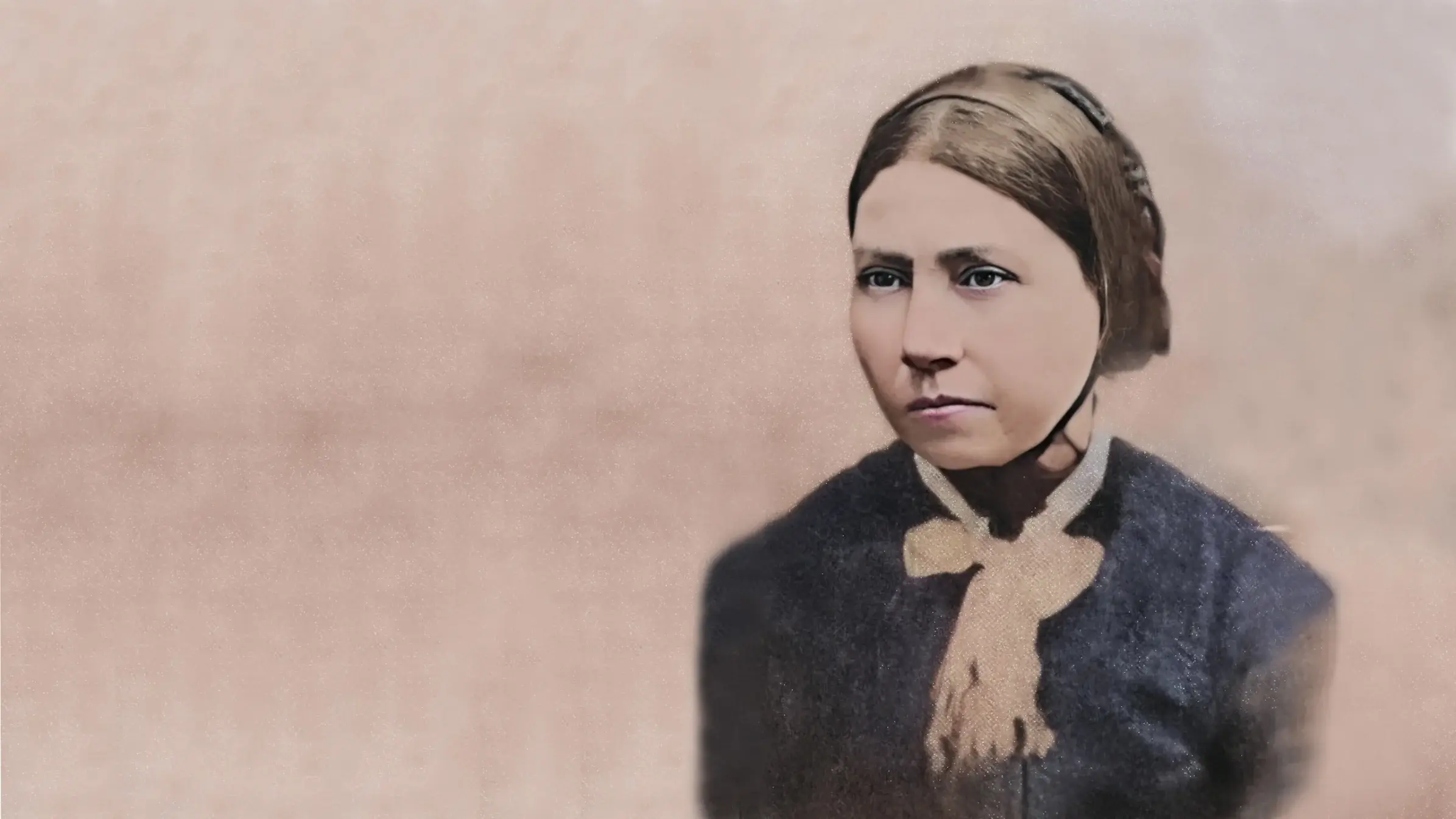The Homecoming of the DS Finmarken
This is a story about a 49-tonne section of an old Norwegian steamship, discovered in the middle of a Dutch forest, and the remarkable effort made to bring it back to its homeland.
The Letter
It all began in 1998, when Sten Magne Engen, chairman of the Coastal Express Museum, received a letter from a passenger on a recent coastal express voyage. At that time, Engen was still captaining ships along the Norwegian coast while tirelessly devoting all his free time preparing for the permanent installation of the MS Finmarken, a coastal steam ship built in 1956 and recently donated to the museum.
Engen recalled that the letter writer did not speak much when on board ship, nor did he make any memorable impression – but the contents of his letter were astonishing indeed.
“The passenger inquired whether I knew about the existence of something called ‘Villa Finmarken’ in Beekbergen, in the southeast of Holland. According to him, it was undoubtedly a section of the coastal steamer, the DS Finmarken, which was built back in 1912”.
Engen knew that the DS Finmarken was finally retired in 1956 when no longer capable of coping with the demanding operations along the extensive Norwegian coast. Her replacement was the “MS Finnmarken” – the very ship Engen was now busy preparing to exhibit at the museum.
After its retirement, the old steamer was purchased by the Young Christian Sailors’ Association (USFK) in Stavanger for use as a training vessel. Then, just three years later, it was sold for scrap in Rotterdam.
That was the last time anyone in Norway knew anything about the DS Finmarken – until the letter landed in Engen’s mailbox nearly four decades later.
“I was thrilled. I thought, at the very least, I had to procure a memento from the vessel”, Engen recollects.
Sten Magne Engen, chairman of the Coastal Express Museum in Stokmarknes.
Ended up at a riding centre
A year later, after overseeing the successful reopening of the Hurtigruten Museum, Engen finally had the opportunity to travel to the Netherlands to inspect the “Villa Finmarken” up close. This is where the story becomes truly fascinating.
It turned out the old steamship had not met its demise in the scrapyard after all. A dentist bought it and moved the entire 16m long, 5m tall section to Beekbergen, near the city of Apeldoorn. It is not known what the dentist planned to do with it or how much he had paid, but a few years later he sold the 49-tonne section to a horse-riding center that was planning to use the ship’s salon and cabin section for lodging and communal spaces for its pupils.
And so it was, there it sat, ensconced in a protective wooden structure, gradually surrounded by a dense forest, until it faded into oblivion.
Photo: Sten Magne Engen
Then another Surprise
Upon arriving at the horse-riding center, Engen was astonished to learn that he could not only obtain a memento from the vessel but purchase the entire thing for 1.5 million Norwegian kroner (about € 147,900) However, there was just one big problem: how on earth would he get the MS Finmarken out of the forest and transport it to Norway and to the museum in Stokmarknes?
“There were 20-meter trees everywhere. I had to go to the Dutch authorities to obtain permission to cut out a passage so we could get the boat out – but the forest was protected, so I was not allowed”, Engen explains.
The process of obtaining permission to carve out a passage for the boat proved to be an arduous one. Despite numerous meetings and applications that eventually reached higher authorities in the Netherlands, it took three long years for the museum chairman to be granted permission to create a “road” through the forest.
“After the trees were felled, we laid down 160 thick steel plates to prevent machinery and vehicles from getting stuck”, Engen recalls.
Once the wooden structure protecting the Finmarken was removed, it became clear that the vessel was surprisingly well-preserved, which boded well for the project.
Photo: Sten Magne Engen
In order for the boat to be transported, it was first jacked up to 30 centimeters (nearly one foot) on both sides before two beams were placed under the deck.
Photo: Sten Magne Engen
Then a 300-tonne crane lifted the 49-tonne Finmarken onto a low-loader lorry for its journey to a dock in nearby Harderwijk, where it would then be transferred onto a canal boat and taken to Amsterdam.
Photo: Sten Magne Engen
The operation started on a dark Saturday morning.
Photo: Sten Magne Engen
“We were able to move the boat from the riding center onto the road, but a series of challenges arose during the journey, and we had to bring along several accompanying cars”.
Photo: Sten Magne Engen
“Branches had to be cut down to make room for the transport, and they had to be immediately shredded”.
Photo: Sten Magne Engen
“And then we had to navigate through a roundabout”, Engen recalls.
The turning radius in the roundabout was so tight that traffic signs were reversed to give the low-loader enough space, but it was completely futile. As a result, the enormous vehicle had to drive against the flow of traffic, with police cars and flashing lights both in from and behind. Fortunately, it was still nighttime and traffic was minimal.
After a four-hour journey, the truck arrived at the dock in Harderwijk, where a canal boat awaited to take the Finmarken on to Amsterdam.
“There, we were able to borrow the entire cruise boat terminal”, Engen says. “I had a valuable contact in Amsterdam who also provided food and drinks for the celebration. We took the opportunity to extend invitations to all the sponsors and other involved parties to commemorate the occasion in the harbour”, says Engen, smiling.
A few days later, Nor-Cargo, a Norwegian sea cargo ship, picked up the Finmarken and delivered her to Bergen completely free of charge. Another shipping company, Nor-Cargo, brought it onto Stokmarknes, where it arrived in the dead-of-night. The following morning, the older steamer arrived at the Coastal Express Museum, where she stood alongside the ship that replaced her in 1956, the MS Finnmarken.
The Restoration
"The restoration of the old Finmarken's interior cost about ten million NOK and consumed several years of dedicated efforts," recountes Engen. He then delves into an anecdote about his visit to the Maritime Museum in Bergen, where he embarked on a mission to 3D-scan all the intricate woodcarvings that once adorned the smoking room of the Finmarken, as this interior has been showcased there ever since it was taken out of the boat.
"I acquired a powerful computer and a large milling machine weighing 1.2 tons from China. With utmost precision, we milled out all the woodcarvings down to a half a millimetre. Furthermore, we enlisted the expertise of skilled woodcarvers to delicately chisel the patterns and illustrations. The resulting designs are captivating, portraying various themes such as war and the Viking age”, Engen explains.
The rest of the interior of Finmarken remains faithful to its 1912 origins, right down to the wallpaper.
"We attempted to locate the exact wallpaper that was once present in the 'Music/Ladies Lounge,' but to no avail. As a result, we contacted Lutz Walter, a specialist from Germany, who found the only European company capable of producing embossed wallpaper. However, before the wallpaper could be produced, it had to undergo a meticulous process of being drawn and coloured to perfection. Lutz persisted with the task and eventually succeeded after seven attempts in creating the desired result”, says Engen.
Whilst the carpet runners were crafted in Belgium, their exquisite designs hail from Norway. The chandeliers that adorn the “Music/Ladies Lounge”, on the other hand, are a product of the Czech Republic. As for the elegant furnishings, they are made in Norway, utilising the very same techniques that were employed back in 1912.
The Piano Hunt
Meanwhile, the Museum persisted in their search to find the ideal piano. Their objective was to acquire a piano that closely resembled the one that was originally present in the music and ladies' lounge during the ship's first voyage.
“Many of the older boats had musical instruments on board, " Engen explains. “The renowned 'Father of the Coastal Express,' Richard With, was musically inclined and played instruments himself. His daughter, Nanna With, followed in his footsteps and became a piano teacher. It is plausible that she performed right here in this lounge”.
The Coastal Express Museum possesses a photograph that depicts half of the original piano that was placed in the music and ladies' lounge aboard the DS Finmarken in 1912. After much research, the Museum concluded that the piano was likely manufactured by the "Brødrene Hals" brand.
“Our first acquisition was from 1911, and it was found at the residence of the customs chief at a place called Sandnessjøen”, says Sten Magne.
On closer inspection, however, it turned out that a small detail on one corner of the musical instrument deviated slightly from the one in the picture.
"That wouldn't do. We had been so meticulous with everything else so far; it had to be '1912' and not some fake," says the museum chairman.
During the extensive search, a piano that had been aboard the old DS 'Richard With' emerged. The vessel had been operating along the Norwegian coast from 1909, but fortunately the piano was brought ashore in Tromsø, just two days before it was sunk during World War II. Additionally, the Museum Chairman acquired a piano from DS "Tordenskiold," an old boat from 1857.
“I gathered several pianos from Oslo, Trondheim, Kirkenes, and Southern Norway. However, an old Brødrene Hals piano unexpectedly surfaced in Stokmarknes, and it was the closest match to the original piano. The owner was relocating and did not wish to take it with him”, Sten Magne continues.
He does not dismiss the possibility that the piano that appeared in Stokmarknes might be the original one that adorned the Finmarken's music and ladies' lounge in 1912.
“Detective work and high-level problem-solving have been integral to every accomplishment we have achieved”, says Engen, smiling. The extent of time he has dedicated to the Coastal Express Museum is so significant that he can scarcely grasp it. However, this project is the epitome of his life's work, and he firmly believes that every second he has spent pursuing it has been worth the effort in the end.
“It is crucial to preserve the history of the Norwegian coastal express history. Moreover, it is fun to make it happen”.
Tekst: Havila Voyages/Josefine Spiro



